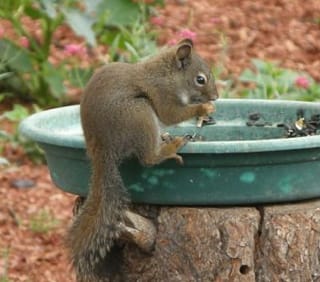This guide initially displays all common mammals. Use the selectors below to view mammals of a particular shape, include rare mammals, or search for them by name.
Mammals are defined as warm-blooded vertebrates with hair or fur and sweat glands — in the females mammary glands, modified sweat glands, produce milk to nourish the young. Most mammals develop a placenta which enables the feeding of the fetus during gestation and give birth to live young. In addition, although most mammals walk on land, many have specific adaptations that allow them to swim, fly, leap between tree branches or even dig extensive tunnels. Many wild mammals are used for both food and fur. while other have been domesticated for their agricultural and scientific importance.
New Mexico ranks high for mammalian diversity in the states in the US and the Pajarito Plateau is home to many of these species. This guide describes all of the larger wildlife found in the area as well as the more common smaller animals with the most abundant being rodents. Local species range from carnivores like the mountain lion and bobcat to ruminants like elk and deer to to several varieties of bats.
Mammal References
Biota Information System of New Mexico
Bogen et al. 1998 Continued Studies of Bat Species of Concern in the Jemez Mountains, New Mexico [PDF]
eNature
Frey et al. 2006 Checklist of New Mexico Mammals [PDF]
New Mexico Tech Mammalian Field Guide
Smithsonian National Museum of Natural History North American Mammals
Threatened, Endangered and Sensitive Species Profile – Los Alamos Laboratory Lands [PDF]
Tyrell and Brack 1992 Survey for Bats in the Los Alamos National Environmental Research Park
Subject Area Experts (all guides)
Steve Cary (butterflies)
Beth Cortright (insects)
Terry Foxx (invasive plants)
Leslie Hansen (mammals)
Richard Hansen (fish, mammals)
Dorothy Hoard (butterflies, trees)
Chick Keller (flowers, herbarium)
Shari Kelley (geology)
Kirt Kempter (geology)
Garth Tietjen (reptiles)
David Yeamans (birds)
Web Development and Content Management
Pat Bacha
Jennifer Macke
Graham Mark
Akkana Peck
Contact
Please contact us for local nature questions and sightings. We welcome comments, corrections, and additions to our guides.
For more information about local nature, please visit our Nature Blog or subscribe to PEEC This Week.
Make Selection
 Photo: Yvonne Keller |  Red Squirrel, American Red Squirrel, Pine Squirrel(Tamiasciurus hudsonicus)Family: Sciuridae (Squirrels, Chipmunks, Marmots, and Prairie Dogs) Size: 10.6 - 15.3 in (27 - 39 cm) Status: native; locally common Habitat: forests and wooded mountains, alpine and subalpine habitats, towns The Red Squirrel has curved front claws and powerful hind legs allowing it to climb and jump in the trees. It is smaller than other squirrels and has a distinctive red coat. In summer it can have black stripes on its sides that fade during winter. Red Squirrels are primarily active in the early morning and late afternoon. They are fierce defenders of their territories making a variety of chattering and screeching sounds. They rarely nest in a burrow but rather have one or more nests in the branches of trees. They will eat a variety of plant materials but specialize in seeds from conifer cones giving them one of their common names of Pine Squirrel. In late summer and early fall, the squirrels gather cones and store them in a central cache for use over the winter. A sure sign of squirrel activity is a large pile of fallen seed cone scales called a “midden”. Tracks Info Photos Distribution |
